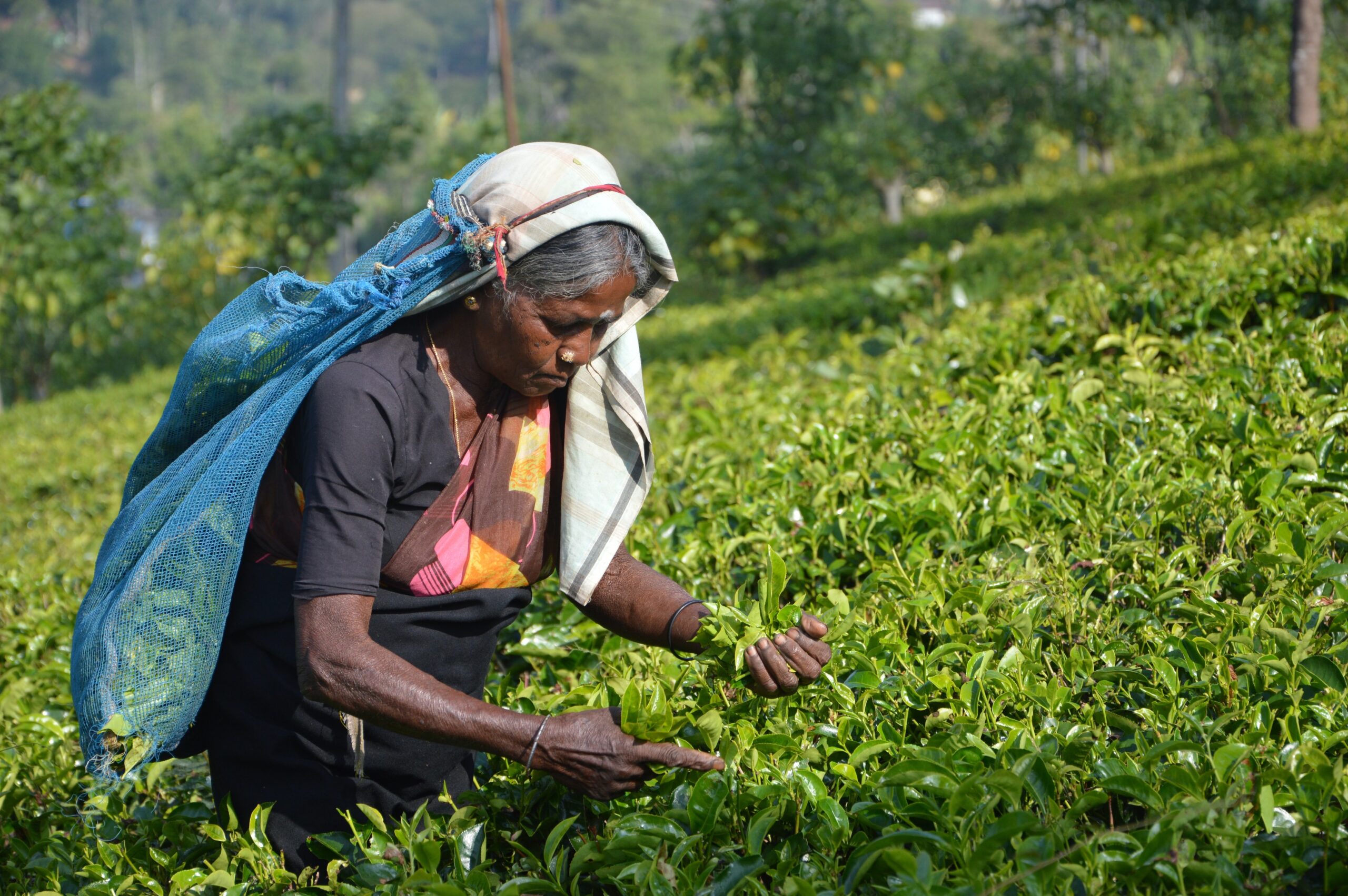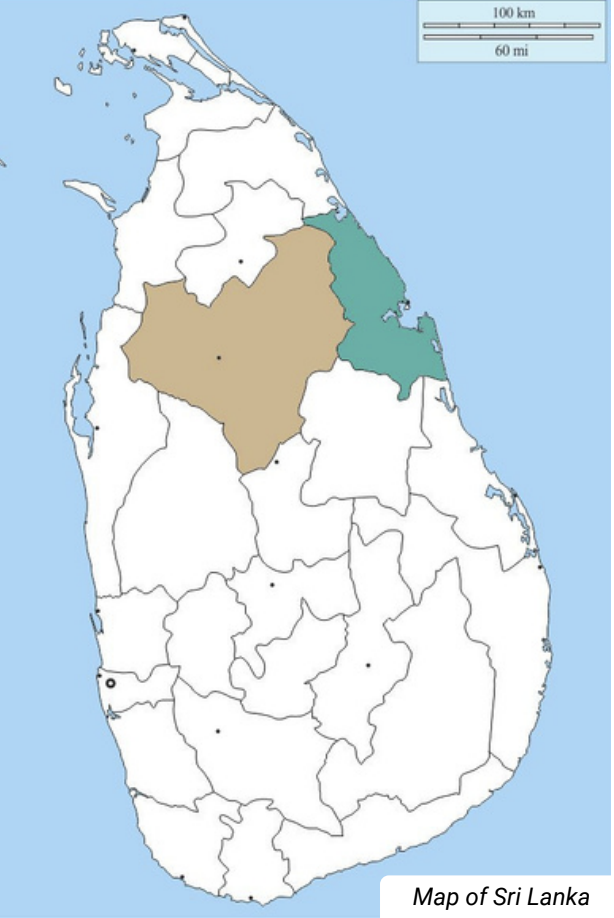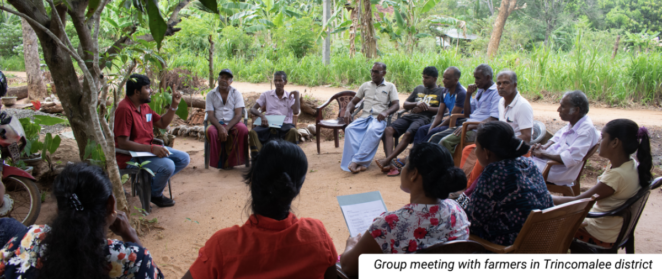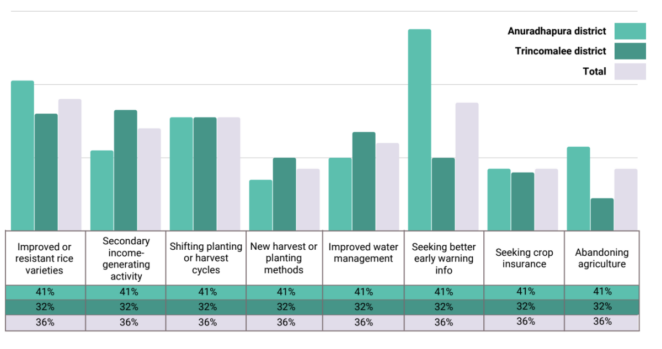The Farmer’s Perspective: Climate Risk and Risk Management in Sri Lanka’s Agriculture Sector

Introduction
Sri Lanka’s food systems revolve around the production of rice as a main staple crop. In addition, fruits and vegetables, grains, meat, fish, and dairy are also important sources of food security. 27.1% of the country’s total population engages in agricultural activities, and agriculture accounted for 7.4% of total GDP in 2020.
Agricultural practices in Sri Lanka are mostly centered on rural areas, with nearly three quarters of Sri Lankan families depending on rural livelihoods such as crop cultivation and livestock raising, which are linked to income generation, food security, and social status.
The dry zone districts of Anuradhapura (marked in brown) and Trincomalee (marked in green) in Sri Lanka’s North Central and Eastern province are home to almost 1.4 million people, 6.3% of the country’s total population. Together, these districts provide close to one fifth of Sri Lanka’s total paddy production as well as a range of other field crops, fruits, and vegetables.
*This weADAPT case study is an abridged version of the original text, which can be downloaded from the right-hand column. Please access the original text for research purposes, full references, and to quote text.

Methodology
The information in this brief is based on a survey, group meetings, and individual follow-up interviews conducted by SLYCAN Trust in Anuradhapura and Trincomalee in 2020-2022. In total, close to 600 farmers, local supply chain actors, and women and youth from farming communities were engaged across four selected Divisional secretariat (DS) divisions. Findings from this process were further supplemented from SLYCAN Trust’s continued work with farming communities in these districts, which has taken place since 2018, as well as input from national and local government officials, experts, researchers, and practitioners.
Key Takeaways
Cultivation cycles and the farmer’s life
The majority of farmers in Sri Lanka’s dry zone districts of Anuradhapura and Trincomalee are smallholders with a heavy reliance on rainfall, low mechanization, and an agricultural calendar revolving around the two annual monsoon seasons:
- The key staple crop is rice, which is supported through a system of major and minor cascade tanks for irrigation.
- The agricultural calendar in Sri Lanka’s dry zone is structured around two cultivation seasons, Maha (the major season with most rain falling from October to March) and Yala (the minor rainy season from April to June).
- Farmers are organized through associations and have grassroot-level structures that facilitate collective decision-making and connect them to local authorities (such as cultivation committees).
- Sri Lanka’s agriculture sector still largely relies on traditional skills and technologies with only limited adoption of modern methods of agriculture.

Key considerations from the farmer’s perspective
Farmer decision-making is based on several variables and considerations that include inputs and assets, risk management, weather data, advisory, rural infrastructure, finance, and insurance (view the full brief to explore each of these categories in more detail):
- Inputs and assets –Agricultural ecosystems are faced with the key challenge of preserving soil fertility and productiveness despite removing significant amounts of nutrients (nitrogen, phosphorus, potassium etc.) with every harvest.
- Risk management –Agricultural operations face a multitude of risks including production risks that affect yield or product quality.
- Weather data and advisory –Farmers need information derived from accurate, timely, and reliable data to make rational cultivation and risk management decisions.
- Rural infrastructure –Infrastructure includes roads and railways, but also the availability of transport vehicles, storage facilities, electricity, water, and other key utilities.
- Finance and insurance– Due to the inherent uncertainties of agricultural cultivation, farmers often rely on savings, community savings, or loans to ensure financial liquidity and allow them to make necessary investments in inputs or machinery.
Challenges and constraints
Major challenges faced by farmers in the two districts include climate-related production risks, fluctuating market conditions, lack of direct market access, and limited financial literacy and trust in insurance solutions:
- These pre-existing risks can be exacerbated or compounded by climate change, which adds an additional layer of uncertainty to agricultural operations.
- Out of the surveyed farmers in Anuradhaprua and Trincomalee district, 92% reported impacts related to high temperatures or heat waves, 88% to rainfall changes, 81% to water scarcity or droughts, and 70% to groundwater scarcity.
- The low diversification of input providers and buyers for paddy and other produce is a key challenge for farmers hoping to get better prices.
- Some of these challenges are further exacerbated through cross-cutting issues. These include, for example, issues related to poverty; lack of risk, financial, or insurance literacy; the vast informal economy of rural areas (including informal farm labour); predatory moneylenders; gender-related inequities; vulnerable groups; or marginalization.
- Farmers in both districts are trying to manage these risks through a variety of new practices or coping methods.

Conclusion
Farmers are aware of the challenges they face and often have a good working understanding of climate-related impacts and production risks. However, many smallholder farmers do not have the necessary awareness, knowledge, technical expertise, equipment, or resources to adequately manage these risks and enhance their livelihood resilience.
Suggested Citation:
SLYCAN Trust (2022). The Farmers’ Perspective: Climate Risk & Risk Management in Sri Lanka’s Agriculture Sector. Colombo, Sri Lanka: SLYCAN Trust (GTE) Ltd.
This knowledge product has been developed as part of the project “Multi-Actor Partnership for Climate and Disaster Risk Financing and Preparedness in the Context of the InsuResilience Global Partnership” supported by the German Federal Ministry for Economic Cooperation and Development (BMZ).
Related resources
- Climate-Smart Land Use Insight Brief No. 3- Climate services to support adaptation and livelihoods
- Climate-Smart Agriculture Sourcebook and Platform
- Sri Lanka: Consolidated Livelihood Exercise for Analysing Resilience
- Does climate information matter? An innovative tool to measure the value of climate services for farmers
(0) Comments
There is no content